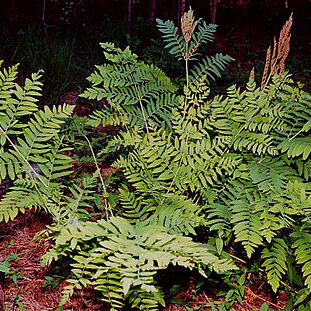Terrestrial homosporous ferns, with short slender erect to decumbent rhizomes or massive undivided or dichotomously-branched arborescent trunks, with a medullated protostele, becoming dictyostelic, non-paleate. Stipes with 2 stipular expansions at the base. Fronds monomorphic or dimorphic, pinnately divided, usually 2-pinnate; vernation circinnate; veins free. Sporangia not in sori, exindusiate, large, subglobular, shortly stalked, maturing simultaneously; annulus consisting of a small group of thickened cells on 1 side of sporangium, dehiscing by a ventral-distal slit. Spores tetrahedral, short-lived, lacking a perispore, green. Gametophyte surface-living, photosynthetic, elongate to obcordate.
Plants terrestrial, herbaceous, frequently in clumps. Stems creeping, beset with old petiole bases and black fibrous roots; scales absent; older stems seldom persisting. Leaves monomorphic or dimorphic. Blades 1--2-pinnate (2-pinnatifid); rachises grooved. Pinnae monomorphic or dimorphic. Indument of reddish to light brown hairs. Veins dichotomous, running to margins. Sori absent; sporangia born on slightly modified fertile segments of blades also possessing fully expanded pinnae, or sporangia covering blades lacking green expanded pinnae, clustered in marginal zones, indusia lacking. Spores green, all alike. Gametophytes green, aboveground, obcordate to elongate.
Terrestrial ferns with suberect rhizomes, clothed with persistent leaf–bases; fronds bipinnate (in W.African species), spirally arranged, when young covered with long simple hairs, base with a stipule–like flange; leaf trace crescent–shaped; sporangia with walls one cell thick borne on both surfaces of fertile pinnules in the upper part of the leaves (in W.African species) pyriform with a short stalk made up of about 5 rows of cells; annulus represented by a cluster of lateral cells with thickened walls
Terrestrial plants with erect or procumbent creeping rhizomes enclosed by a mass of persistent stipe-bases which are winged at the base
Terrestrial plants with erect or procumbent creeping rhizomes enclosed by a mass of persistent stipe-bases which are winged at the base

